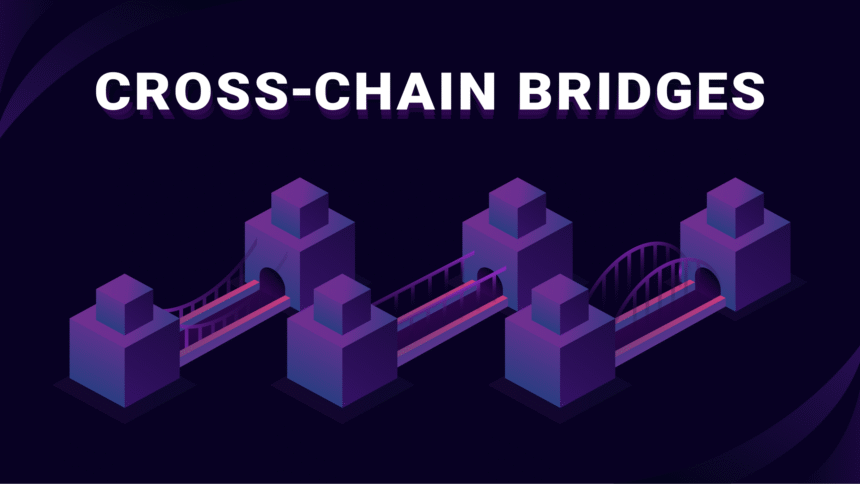One job of modern blockchain infrastructure is to solve problems that blockchains created for themselves. If you want to send money to someone, you can use a bank transfer, which works pretty much the same way everywhere and has worked more or less reliably for decades. If you want to send cryptocurrency to someone, you first need to figure out which blockchain they’re using, whether your blockchain can talk to their blockchain, and whether there’s a bridge between the two that won’t accidentally lose your money in a smart contract bug.
We are living through a fascinating period where different blockchain ecosystems are simultaneously trying to be the “one chain to rule them all” while also acknowledging that multiple chains will probably exist forever, which creates a thriving market for cross-chain bridges. These are protocols that let you move assets between incompatible blockchain networks, like moving from Ethereum to Solana when you want to swap ETH to SOL because Solana promises faster transactions and lower fees, assuming you don’t mind the occasional network outage.
Why People Want to Move Money Between Blockchains (And Why That Makes Sense)
The Grass Is Always Greener on the Other Blockchain
The appeal of cross-chain trading is fundamentally about opportunity arbitrage, though “arbitrage” might be giving it too much credit. Solana has positioned itself as the high-performance alternative to Ethereum, with transaction costs measured in fractions of a penny rather than tens of dollars, and confirmation times measured in seconds rather than minutes. This creates genuine use cases where activities that are economically viable on Solana become prohibitively expensive on Ethereum.
Consider the simple act of buying an NFT. On Ethereum, you might pay $50 in gas fees to buy a $100 NFT, which is either a 50% transaction cost or a strong incentive to only buy very expensive NFTs. On Solana, the same transaction might cost $0.01, which means you can profitably trade much smaller amounts. This isn’t just theoretical-it’s created entire categories of economic activity that only make sense on low-cost blockchains.
The Network Effects Problem
There’s also a network effects angle here that’s quite interesting. Most users have most of their crypto assets on Ethereum, because that’s where the liquidity and established protocols are. But new and potentially lucrative opportunities are increasingly launching on alternative chains, because that’s where it’s actually affordable to experiment with novel financial mechanisms.
This creates a classic chicken-and-egg problem: users won’t move to new chains until there are compelling opportunities, but developers won’t build on new chains until there are users. Cross-chain bridges are essentially a solution to this coordination problem, allowing users to maintain their primary holdings on Ethereum while selectively moving assets to other chains for specific opportunities.
Of course, this also creates new forms of fragmentation and complexity that didn’t exist when everyone used the same blockchain. But complexity is apparently the price we pay for having multiple competing blockchain ecosystems, each of which is convinced it has solved the fundamental tradeoffs that limit the others.
Understanding Bridge Performance Metrics (And Why They Matter)
Speed: The Illusion of Instant Settlement
When evaluating cross-chain bridges, “speed” turns out to be more complicated than it first appears. The advertised transaction time usually refers to how long it takes for the bridge protocol to confirm that your assets have been locked on the source chain and minted on the destination chain. But this doesn’t include the time it takes for your original transaction to confirm on the source chain, or the time it might take to actually use your newly bridged assets on the destination chain.
For example, a bridge might claim “5-minute transfers” between Ethereum and Solana, but if Ethereum is congested and your initial transaction takes 20 minutes to confirm, your total transfer time is actually 25 minutes. And if you’re trying to use your bridged assets immediately for a time-sensitive DeFi opportunity, you might discover that the destination protocol requires additional confirmations before accepting your freshly bridged tokens.
The speed differences between bridges often come down to their security models and the number of confirmations they require before processing transfers. Faster bridges typically take more risks by requiring fewer confirmations, while slower bridges prioritize security by waiting for deeper confirmation of the source transaction.
Cost: The Hidden Fee Structure
Bridge costs involve multiple layers of fees that can quickly add up. You’ll pay Ethereum gas fees to initiate the bridge transaction, which can range from $10 to $100 or more depending on network congestion. You’ll pay the bridge protocol’s own fees, which typically range from 0.1% to 1% of the transfer amount. You might pay slippage costs if the bridge uses automated market makers for token conversion. And you’ll pay destination chain fees to claim your bridged assets, though these are usually negligible on chains like Solana.
The economics get particularly interesting for smaller transfers, where fixed costs can overwhelm the value being transferred. A $20 bridge fee might be reasonable for a $10,000 transfer, but it makes a $100 transfer economically pointless. This creates natural minimum viable transfer sizes that vary depending on current gas prices and bridge fee structures.
Some bridges try to optimize costs by batching multiple user transactions together, but this can increase transfer times. Others offer fee discounts for larger transfers or for users who hold the bridge protocol’s native token, which creates additional complexity around whether those tokens are worth acquiring.
Security: The Fundamental Tradeoff
Security in cross-chain bridges is fundamentally about trust assumptions, and different bridges make different tradeoffs between security, speed, and decentralization. Some bridges are essentially custodial services-you send your Ethereum to a multi-signature wallet controlled by the bridge operators, and they promise to send you equivalent Solana tokens. This is simple and can be relatively fast, but it requires trusting the bridge operators not to steal your money.
Other bridges use smart contracts to lock your assets and mint equivalent tokens on the destination chain, which removes human operators from the process but introduces smart contract risk. These bridges are only as secure as their code, and smart contract bugs have resulted in hundreds of millions of dollars in losses across various DeFi protocols.
The most sophisticated bridges use cryptographic proofs to verify cross-chain transactions without requiring trust in either human operators or smart contracts, but these systems are complex and often slower than simpler alternatives. The security-speed-decentralization tradeoff is real, and different users will reasonably make different choices based on their priorities and risk tolerance.
Evaluating Specific Bridge Options
Wormhole: The Institutional Choice
Wormhole has positioned itself as the infrastructure-grade solution for cross-chain transfers, with support for over 30 blockchains and integration into major DeFi protocols. It’s backed by Jump Crypto, which provides both credibility and resources for security audits and ongoing development. The protocol uses a network of validator nodes to verify cross-chain transactions, which provides decentralization but also creates coordination challenges.
From a user perspective, Wormhole offers reasonable speed (typically 5-10 minutes for Ethereum to Solana transfers) and competitive fees, though not necessarily the lowest in either category. Its main advantage is reliability and integration-because so many protocols support Wormhole-bridged tokens, you’re less likely to encounter compatibility issues on the destination chain.
The security model involves validator consensus, which means transfers require approval from a majority of validator nodes. This provides protection against individual validator failures but creates systemic risk if the validator set becomes compromised or coordinated. The 2022 Wormhole hack, which resulted in $320 million in losses, demonstrated both the risks of this model and the importance of having adequate insurance funds to cover losses.
Allbridge Core: The Stablecoin Specialist
Allbridge Core has carved out a niche in efficient stablecoin transfers, which makes sense because stablecoins have less price volatility and more predictable demand patterns than other crypto assets. The protocol focuses on capital efficiency by maintaining liquidity pools on both source and destination chains, which can provide faster transfers and lower slippage for supported assets.
The specialization in stablecoins creates both advantages and limitations. Transfers of USDC or USDT between Ethereum and Solana are typically faster and cheaper through Allbridge than through more general-purpose bridges. But if you want to bridge ETH itself or other volatile assets, you’ll need to use a different bridge or convert to stablecoins first, which adds complexity and additional transaction costs.
The liquidity pool model also means that bridge capacity can vary depending on pool balances. During periods of high demand for transfers in one direction, pools can become imbalanced, leading to higher fees or temporary unavailability for transfers in that direction.
Symbiosis Finance: The Swiss Army Knife
Symbiosis Finance takes a different approach by functioning more as a cross-chain swap protocol than a traditional bridge. Instead of simply moving tokens between chains, it can swap between different tokens across different chains in a single transaction. Want to convert ETH on Ethereum to SOL on Solana? Symbiosis can do that directly, without requiring you to bridge ETH first and then swap for SOL.
This functionality is genuinely useful and can save both time and transaction fees for certain use cases. But it also introduces additional complexity and risk, because the protocol needs to manage both cross-chain transfers and token swaps, each of which has its own potential failure modes. The smart contracts are necessarily more complex, which increases the risk of bugs, and the system relies on cross-chain liquidity that might not always be available at favorable rates.
The speed advantage is real-completing both a bridge and a swap in a single transaction is faster than doing them sequentially. But the cost advantage depends on the specific tokens involved and current liquidity conditions, and can sometimes be offset by the complexity premium built into the protocol’s fee structure.
Security Best Practices (Or: How Not to Lose Your Money)
Due Diligence for Smart Contract Risk
Cross-chain bridges represent some of the highest-risk infrastructure in DeFi, because they hold large amounts of cryptocurrency in smart contracts that interact with multiple blockchain networks. Before using any bridge, it’s worth researching the protocol’s security practices, audit history, and track record.
Look for bridges that have undergone multiple security audits by reputable firms, but remember that audits are point-in-time assessments and don’t guarantee future security. Code can be updated after audits, new attack vectors can be discovered, and even audited code can have bugs that weren’t caught during the review process.
Pay attention to the bridge’s governance structure and upgrade mechanisms. Bridges that can be upgraded by a small number of administrators create centralization risks, while bridges with immutable code might be unable to fix bugs if they’re discovered. There’s no perfect solution, but understanding the tradeoffs can help you make informed decisions about which risks you’re comfortable accepting.
Operational Security for Users
From a user perspective, the biggest security risk is often not the bridge protocol itself, but the operational security around using it. Phishing attacks targeting bridge users are common, because bridge transactions involve significant amounts of cryptocurrency and complex multi-step processes that can be confusing for users.
Always verify bridge contract addresses through official channels rather than clicking links in emails or social media posts. Use hardware wallets for large transfers. Consider breaking large transfers into multiple smaller transactions to limit potential losses from any single failure. And be prepared for the psychological stress of having significant amounts of money locked in smart contracts that you don’t fully understand and can’t control.
The most expensive bridge security failures are often the result of user error rather than protocol failures-sending assets to wrong addresses, falling for phishing scams, or approving malicious smart contracts that drain wallet funds. Technical solutions can’t fix human problems, which means careful operational security remains essential.
The Future of Cross-Chain Infrastructure
Regulatory and Technical Evolution
The cross-chain bridge landscape is evolving rapidly on both technical and regulatory fronts. New protocols are experimenting with zero-knowledge proofs and other cryptographic techniques to provide faster, cheaper, and more secure cross-chain transfers. Layer-2 scaling solutions are creating new opportunities for bridging between different Ethereum scaling solutions as well as between entirely different blockchains.
From a regulatory perspective, cross-chain bridges exist in a gray area where traditional financial regulations don’t map cleanly onto the technical reality of how these protocols work. As regulators develop more sophisticated understanding of cross-chain infrastructure, we can expect new compliance requirements that might favor certain bridge architectures over others.
Conclusion: Navigating the Cross-Chain Future
Cross-chain bridges represent both the promise and the peril of a multi-blockchain future. They enable genuinely useful functionality-letting users take advantage of different blockchain ecosystems without being locked into any single one. But they also introduce new risks and complexity that didn’t exist when everyone used the same blockchain.
The key to using bridges successfully is understanding that you’re making tradeoffs between speed, cost, security, and convenience, and different bridges optimize for different parts of that equation. The “best” bridge for any particular use case depends on your specific needs, risk tolerance, and the current state of network conditions across the relevant blockchains.


